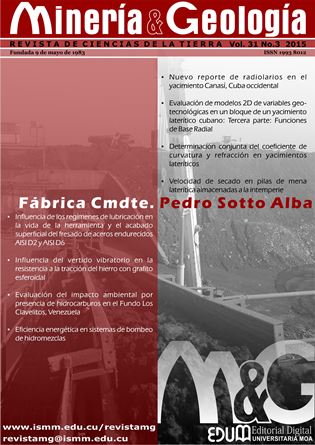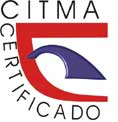New radiolarian report in canasi ore body, western Cuba
Keywords:
Canasí-1x, radiolarian, paleontology, West of CubaAbstract
Radiolarians, within the siliceous microfossils, constitute one of the most diverse protozoa groups. In general they are in compacted rocks: which makes it difficult to study. To the Northern Strip of the Heavy Crudes (FNCP, acronym in Spanish), the main sealing rocks are the sequences of the Paleocene-Eocene, in which calcareous microfossils are non-existent or very scarce, however, there are plenty of radiolaries. A total of 10 samples were analyzed in the Research Center Bio-stratigraphic Lab. These samples were taken from the Canasi pit 1x of the ore body bearing the same name at an interval of 1 780-2 020 m belonging to the High Vega Formation. The samples correspond to the siliceous-clayey facies in the core area and near the east. The methods implemented included the levigated, the section in suspension and the Scanning electron microscopy. This allowed determining 21 species of radiolaries within the genres of Entapium, Theocosphaera, Spongodiscus, Paracenodiscus, Buryella, Calocycloma, Lychnocanium, Theocotylissa, Dictyoprora, Podocyrtis, Phacodiscus, Conosphaera, Cenosphaera and Dictyomitra. It was possible to restrict the age of the sequence and report for the first time the existence of the Phacodiscus duplus species in Cuba.Downloads
References
EHRENBERG, C. G. 1847: Über die mikroskopischen kieselschaligen Polycystinen als mächtige Gebirgsmasse von Barbados und über das Verhältniss deraus mehr als 300 neuen Arten bestehenden ganz eigenthumlichen Formengruppe jener Felsmasse zu den jetzt lebenden Thieren und zur Kreidebildung Eine neue Anregung zur Erforschung des Erdlebens. Bericht der königlichen preussichen Akademie der Wissenschaften zu Berlin, 40-60.
FLOREZ-ABÍN, E. 1983: Radiolarios de algunas formaciones del Cretácico y Paleógeno Inferior de Cuba Occidental. Ciencias de la Tierra y del Espacio 7: 3-36.
FLOREZ-ABÍN, E. 1986: Lista de Radiolarios de Cuba. Contribuciones Científicas. Museo de Ciencias “Felipe Poey”. Ciudad de La Habana.
FLOREZ-ABÍN, E.; DELGADO-CARBALLO, I. & PÉREZ-MACHADO-MILÁN, O. 2013: Radiolarios del Cretácico Superior de la zona Habana-Matanzas, Cuba. En: V Convención Cubana de Ciencias de la Tierra (Memorias) ISSN 2307-499X.
HAECKEL, E. 1881: Entwurf eines Radiolarien-Systems auf Grund von Studien der Challenger-Radiolarien. Jenaische Zeitschrift für Naturwissenschaft 15(3): 418-472.
OLIVERO, E. B.; MALUMIÁN, N.; PALAMARCZUK, S. & SCASSO, R. A. 2002: El Cretácico superior-Paleógeno del área del río Bueno, costa atlántica de la Isla Grande de Tierra del Fuego. Revista de la Asociación Geológica Argentina 57(3): 199-218.
PERCH-NIELSEN, K. 1985: Cenozoic calcareous nannofossils. En: H. M. BOLLI; K. PERCH-NIELSEN & J. B. SAUNDERS (eds.) Plankton Stratigraphy. Cambridge University Press, p. 427-554.
PÉREZ-MACHADO-MILÁN, O.; DELGADO-CARBALLO, I. & FLOREZ-ABÍN, E. 2013: Atlas de Radiolarios del Paleoceno-Eoceno de Cuba Occidental. En: V Convención Cubana de Ciencias de la Tierra (Memorias). ISSN 2307-499X.
RIEDEL, W. R. 1971: Systematic classification of polycystine Radiolaria. The Micropalaeontology of Oceans. Cambridge University Press, p. 649-660.
SANFILIPPO, A.; WESTBERG-SMITH, M. J. & RIEDEL, W. R. 1985: Cenozoic Radiolaria. En: H. M. BOLLI; K. PERCH-NIELSEN & J. B. SAUNDERS (eds.) Plankton Stratigraphy. Cambridge University Press, p. 631-712.
Published
How to Cite
Issue
Section
- Authors retain copyright and guaranteeing the right magazine to be the first publication of the work as licensed under a Creative Commons Attribution-NonCommercial that allows others to share the work with an acknowledgment of the work's authorship and initial publication in this journal.
- Authors may establish separate supplemental agreements for the exclusive distribution version of the work published in the journal (eg, place it in an institutional repository or publish it in a book), with an acknowledgment of its initial publication in this journal.
- Authors are allowed and recommended to disseminate their work through the Internet (e.g., in institutional telematic archives or on their websites) before and during the submission process, which can produce interesting exchanges and increase citations of the published work. (See The effect of open access)










